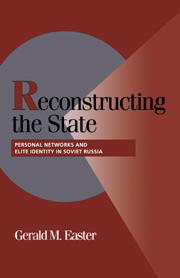
-
Select format
-
- Publisher:
- Cambridge University Press
- Publication date:
- October 2009
- January 2000
- ISBN:
- 9780511571527
- 9780521660853
- 9780521035873
- Dimensions:
- (228 x 152 mm)
- Weight & Pages:
- 0.475kg, 238 Pages
- Dimensions:
- (228 x 152 mm)
- Weight & Pages:
- 0.366kg, 240 Pages
You may already have access via personal or institutional login
Book description
Why do some state-building efforts succeed when others fail? Using formerly unavailable archival sources, this book presents an explanation for the rise and subsequent collapse of the Soviet state. The study explains how personal networks and elite identity served as informal sources of power that influenced state strength. Reconstructing the State also offers alternative interpretations of how the weak Bolshevik state extended its reach to a vast rural and multi-ethnic periphery as well as the dynamics of the center-regional conflict in the 1930s that culminated in the Great Terror.
Reviews
‘Easter’s superb study illuminates the heretofore underappreciated role of regional elite networks in the evolution of the Soviet state. This lucidly written book is a fine political history embedded in a sophisticated and useful theoretical framework. It is an important contribution to political science and Soviet history.’
Zoitan Barany - University of Texas, Austin
Contents
Metrics
Altmetric attention score
Full text views
Full text views help Loading metrics...
Loading metrics...
* Views captured on Cambridge Core between #date#. This data will be updated every 24 hours.
Usage data cannot currently be displayed.
Accessibility standard: Unknown
Why this information is here
This section outlines the accessibility features of this content - including support for screen readers, full keyboard navigation and high-contrast display options. This may not be relevant for you.
Accessibility Information
Accessibility compliance for the PDF of this book is currently unknown and may be updated in the future.


